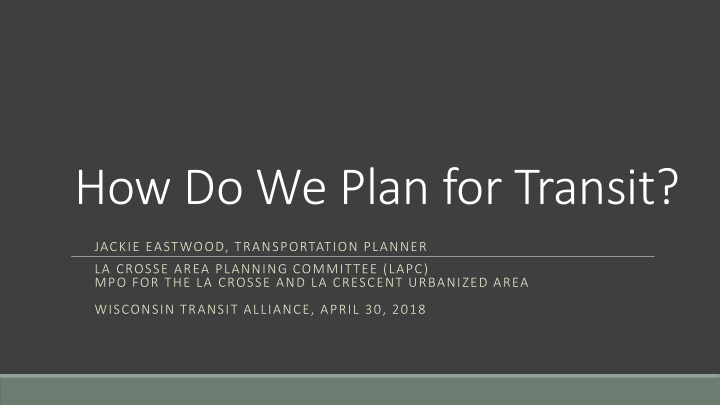



How Do We Plan for Transit? JACKIE EASTWOOD, TRANSPORTATION PLANNER LA CROSSE AREA PLANNING COMMITTEE (LAPC) MPO FOR THE LA CROSSE AND LA CRESCENT URBANIZED AREA WISCONSIN TRANSIT ALLIANCE, APRIL 30, 2018
Overview Background and duties of the LAPC Transit services in the La Crosse area Transit Planning at the LAPC Required Elements for Providing Transit Service Challenges for Transit
What is the LAPC? WHO WE ARE AND WHAT WE DO
LAPC Organization Metropolitan planning organization (MPO) ◦ Federal transportation bill ◦ Urbanized areas of 50,000 people or more Bi-State MPO ◦ Wisconsin and Minnesota Classified as a small MPO (<200,000 people) ◦ About 118,000 people ◦ Can’t apply for most grants ◦ No regulatory authority ◦ Don’t receive federal funds directly—comes through States
LAPC Structure LAPC Policy Board We are advisory ONLY! Staff We facilitate & coordinate! Technical Committee on Advisory Transit and Active Committee Transportation
LAPC Duties Metropolitan Transportation Plan Transportation Improvement Program Planning Work Program Public Participation Plan Title VI Plan Modal studies and plans ◦ Bicycle and Pedestrian Safety Study ◦ Transit Development Plan for MTU
Transit Services in the La Crosse Area
History of Transit in La Crosse 1879 – businessmen began privately- owned horse-drawn system 1893-1923 – Horse-drawn system converted to electrified streetcar system 1929-1935 – Streetcar routes converted to bus routes Privately-owned until 1974 when the City of La Crosse purchased the La Crosse Transit Company La Crosse MTU began operations in 1975
Current General Public Transit Services La Crosse Municipal Transit Utility (MTU) ◦ Owned and operated as a department within the City of La Crosse Onalaska/Holmen/West Salem Public Transit (OHWSPT) ◦ Administered by the City of Onalaska ◦ Contracted with a private provider ◦ Began in 1999 Scenic Mississippi River Transit (SMRT) ◦ Administered by the City of Prairie du Chien ◦ Contracted with a private provider ◦ Began in 2012
La Crosse MTU Nine fixed routes ◦ Five City routes that operate 7 days per week ◦ One City route that operates weekdays only ◦ Three contract routes (renewed annually) ◦ La Crescent, MN (1998): Weekdays and Saturdays ◦ City of Onalaska (1999): Weekdays only ◦ French Island & La Crosse Airport (2000): Weekdays only Deviated fixed-route and complementary paratransit Free transfers between MTU and OHWSPT Allows SMRT to use MTU bus stops Jefferson Lines bus bay at GRS Bike racks on all buses; bike racks and lockers at GRS
Onalaska/Holmen/West Salem Public Transit (OHWSPT) Door-to-door shared-ride taxi service operating 7 days per week Origin and destination need to be in the City of Onalaska, the Village of Holmen, or the Village of West Salem Free transfers from/to MTU at Center 90 and Valley View Mall City of Onalaska initiates RFP for a shared-ride service provider every five years ◦ Running, Inc has had the contract since inception in 1999
Scenic Mississippi Regional Transit (SMRT) Regional fixed routes: ◦ Prairie du Chien – La Crosse (Dec 2012) ◦ LaFarge/Viroqua – La Crosse (Dec 2012) ◦ Tomah – La Crosse (Oct 2017) Funded through the 5311 Rural Program Multi-jurisdictional support Looking to expand to Arcadia
Other Regional Transportation Services JEFFERSON BUS LINES AMTRAK Designated bus stop at Grand River Station No direct MTU bus service Ticket agent
Transit Planning at the LAPC
Local Transit Planning LA CROSSE MTU TRANSIT DEVELOPMENT PLAN Operations and performance Density Criteria Availability and access ◦ 60-minute service ◦ Service frequency and hours ◦ 4-9 jobs per acre ◦ Coverage (transit-supportive areas) ◦ 3-6 households per acre ◦ Contracted service ◦ 30-minute service ◦ Multimodal connections ◦ > 9 jobs per acre ◦ Environmental (social) justice ◦ > 6 households per acre Comfort and convenience
Regional Transit Planning COMMUTER BUS SERVICE FEASIBILITY PLAN Expansion of SMRT to Arcadia and Tomah Tomah route implemented as pilot in October 2017 MRRPC, LAPC, La Crosse County, and UW Extension
Regional Transit Planning TWIN CITIES-MILWAUKEE-CHICAGO (TCMC) INTERCITY PASSENGER RAIL SERVICE STUDY LAPC provided $40,000 in support in 2017 WisDOT and MnDOT are requesting $40,000 in 2018 to help fund phase 2 ◦ NEPA work ◦ Service Development Plan
Regional Transit Planning TWIN CITIES TO MILWAUKEE HIGH-SPEED RAIL CORRIDOR Staff participates in technical committees: ◦ Minnesota Passenger Rail Forum ◦ Minnesota High-Speed Rail Commission ◦ Twin Cities-to-Milwaukee HSR Corridor ◦ Midwest Rail Plan
Required Elements for Providing Transit Service
Local Sponsor
Federal and State Funding Program Description Federal/State Share Bus and Bus Facilities Federal discretionary grant for capital 80% (Section 5339) Federal Formula Grant for Capital, planning, and operating assistance to states for 80% capital; Rural Areas (5311) public transit in rural areas with populations less than 50% operating; 50,000 80% paratransit Federal Formula Grant for Capital assistance for large areas (>200,000); capital and 80% capital; Urbanized Areas (5307) operating assistance for areas with 50,000-200,000 people 50% operating State Urban Mass Transit State operating assistance; often combined with the 5307 80% Operating Assistance (85.20) Wisconsin Employment Program to connect low-income workers with jobs 80% capital; Transportation Assistance 50% operating
Local Match Percentage of project cost ◦ Generally 20% for capital and 50% for operations Can come from multiple sources ◦ Municipalities ◦ Businesses ◦ Non-profits
Service Provider Contracted through a competitive bid process ◦ Required at least every 5 years
Challenges for Transit
Local Support Competition with other needs and goals ◦ Capital budgets Sustainable source of funding ◦ Operations ◦ Vehicle maintenance and replacement Naysayers and nimbys
Political Will and Priorities
Recommend
More recommend